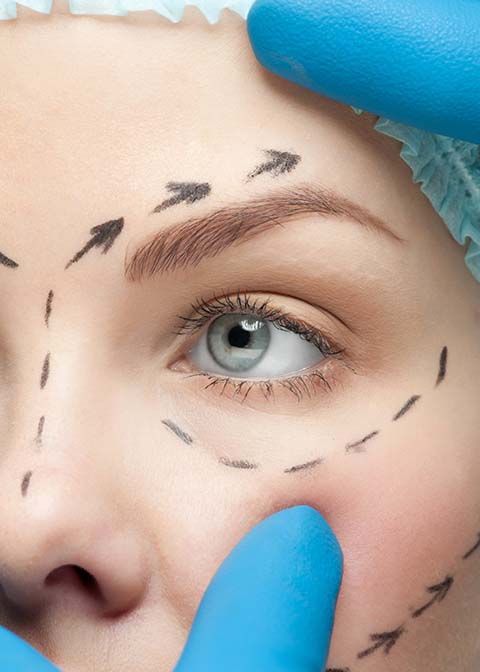Lowered Eyelids Causes and Treatment
Dropping Eyelashes, also called ptosis, can occur due to trauma, age or various medical disorders.
This condition is called unilateral pitosis, when it involves one eye and a bilateral ptosis when it affects both eyes.
Drooping Eyelids may be temporary or may be permanent. They can be present at birth, which is known as congenital ptosis, or you can develop them later in life, which is known as the acquired ptosis.
Depending on the weight of the condition, the lowered eyelids can block or greatly reduce the vision of the person who has them, depending on how much they obstruct the pupil.
In most cases, this condition can be successfully solved, either naturally or by correction of the eyelids so-called. Blepharoplasty.
Risk factors
There are many different possible causes and risk factors for the emergence of lower eyelids, from natural causes to serious health conditions.
Namely, everyone can have drooped eyelids, without significant differences in prevalence between men and women.
However, drooping eyelids are most commonly seen in older people, which is quite logical, due to the natural aging process. The levator is a muscle that is responsible for normal functioning and lifting of the eyelid, loses it’s tone as you age. The loss of muscle tone causes the skin to sag, thus resulting in drooping eyelids.
Sometimes the exact cause of the drooped eyelids is quite unknown, and it is known that this can sometimes be a consequence of a trauma. Also, this condition can be neurologically associated with some other states that effect the body.
Certain medical conditions may increase the risk of developing drooping eyelids. If your eyelids are lowered, this can be a sign of a basic health condition, especially if the problem affects both eyelids.
If only one of your eyelids falls, this can be the result of a nerve injury or just a temporary state. In some instances cataract surgery is sometimes responsible for the development of ptosis, as a result of stretching of the muscles or tendons.
In some cases, dropped eyelids are caused by serious conditions, such as stroke, brain tumor, or nerve or muscle cancers.
Neurological disorders affecting the nerves or muscles of the eyes – such as myasthenia gravis – can also lead to ptosis.
What are the symptoms of lowered/drooping eyelids?
The basic symptom of lowered eyelids is when one or both upper eyelids drop/fall. In some cases this may affect your vision. However, in most patients, drooping eyelids are barely noticeable, it does not occur permanently and is not long-lasting.
Also, you can have extremely dry or teary eyes, and you may notice that your face looks tired, thinking that you have lowered eyelids, which affects your own perception of yourself, and gives oyu a negative appareance of your eyelids.
Diagnosis
The doctor will perform a physical examination and ask you about your medical history. Once you explain how often and how long you have had drooped eyelids, your doctor will perform some tests to find the specific causes.
A doctor can carefully look at your eye with the help of high-intensity light. Another examination that can be used to diagnose drooped eyelids is the Tensilon test.
Treatment of lowered eyelids
Treatment of lowered eyelids differs from patient to patient and depends on the specific cause and severity of the condition.
If the drooping is a result of age or something you were born with, your doctor will probably explain that this condition is usually not harmful to your health. However, you can opt for eyelid plastic surgery if you want to improve your appearance.
If a doctor finds that eyelid drooping is caused by a basic health condition, you will be treated accordingly. Removing the underlying causes should usually stop the drooping of the eyelids.
If your lowered eyelid blocks your vision, you will need medical treatment. In this case, you can expect a doctor to recommend the eyelid surgery
Sometimes the appropriate glasses that can hold the lid up are another option that can help you. This treatment is often the most effective when drooped eyelids are only temporary.
Glasses for Drooped Eyelids
The use of specific eyewear is a non-surgical option that involves adding a specific add-on to the frames of your glasses. This add-on prevents the eyelids from drooping down.
There are two types of such “crutches” for drooped eyelids: adjustable and reinforced.
Adjustable “crutches” are attached to one side of the frame, while reinforced “crutches” are attached to both sides of the frame.
Crutches can be installed on almost all types of glasses, but they work best on metal frames.
Lower Eyelid Surgery
In more serious cases, your doctor may recommend an operation of lower eyelids. During this procedure, the levator muscle is tightened as needed, which should be the solution to this problem.
This will definitely lift the lid to the desired position. For children who have ptosis, doctors sometimes recommend eyelid surgery to prevent the onset of lazy eyes (amblyopia).
However, there are risks associated with surgery, including the dry eye, scratched cornea and hematoma.
There is another type of surgery in which the muscles at the forehead are used to lift the eyelids. Eyelid surgery nowadays does not have to be exclusively for health, but can also be applied for aesthetic reasons. So, for eyelid surgery, those who want to give their face a rejuvenated look are also welcomed.
Because drooping eyelids affect a person greatly their face looks worn out, tired and exauhsted. Raised eyelids make the face look rested, fresher, more cheerful, and therefore younger.
If you are being bothered by drooping eyelids and want more information, please call the Atlas General Hospital call center and schedule consultations: +381 11 785 88 88.

